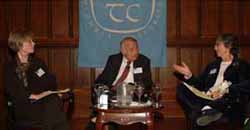Ann Lieberman and Diane Wood Go Inside the National Writing Project
To find out if networks make a difference in classroom teaching, Ann Lieberman and Diane R. Wood studied the National Writing Project, one of the most influential and long-lasting professional development programs in the United States. With 175 school-university sites in 49 states, The Writing Project has the reputation of being a career-altering professional development experience.
Their studies culminated in a book called, Inside the National Writing Project: Connecting Network Learning and Classroom Teaching, which analyzes what makes the Project so successful, and shows how other professional development efforts can learn from it. At the last TC Booktalk of the semester, the two authors discussed their book with moderator Richard Heffner, Host of PBS's "The Open Mind," in the Milbank Chapel.
The book describes the principles of the Writing Project, its activities, its social practices, and the complexities involved in building and sustaining such a network. Co-authors Wood and Lieberman struggled to figure out what bonded these teachers and made them internalize accountability. They noticed that the way they interacted socially transcended their institutions, geography, grade level and subject areas.
Wood, who had the task of naming this cultural connection, came up with "social practices" which refers to how the teachers build relationships and interactions to take each other seriously. This builds respect and a collective sense of responsibility toward students. Some of the social practices that she talked about were: approaching each individual as a contributor, teachers teaching other teachers, and creating public forums for sharing dialogue and criticism.
Bringing teachers together to share the knowledge they have accrued over the years is essential. "In other places they are still doing professional development by bringing people in to tell teachers what to do," said Lieberman. "They think it's easy and efficient, but it's really throwing money down the hole."
They studied the activities of two sites of the Writing Project-one urban and one rural-while interjecting the voices of the participants throughout the book. Lieberman, who is a TC emeritus professor and senior scholar at The Carnegie Foundation for the Advancement of Teaching and a visiting professor at Stanford University, observed a Writing Project in Los Angeles. Wood, who is an assistant professor in the College of Education and Human Development at the University of Southern Maine, studied one in rural Oklahoma.
"I went to Oklahoma and it was nothing but flat plains, some fields and little towns," said Wood. "But the characteristics about dialogue and interactions were still particular to the Writing Project. I met with so many people and they all had the same cultural thing in common."
To illuminate the link between network learning and classroom teaching, they followed six teachers who participated in the National Writing Project institutes to see what they took back to their classrooms. They chose two brand-new teachers, two mid-career teachers and two veterans. They were all women, all energetic and all committed to education. When they brought the six teachers together in Los Angeles for a meeting, the teachers, who were from different places, bonded quickly and were swapping ideas by the end of the day.
Lieberman and Wood describe a different way of thinking about professional development in their study-one that involves teachers in their own learning, builds teacher leadership, and sustains teacher commitment to improvement.
Many teachers in the National Writing Project develop not only a writing voice, but their regular voice as well. One teacher, Linda, realized that she was a writer, a learner and a teacher during her program. "She had an epiphany during the institute," said Wood, "where she stopped asking ‘where are the answers' and realized that ‘we, the teachers, are the answers.'"
Published Thursday, May. 1, 2003
